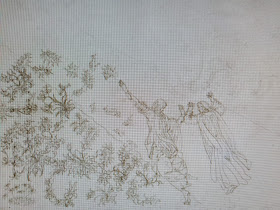After paradise in the mouth it was time to give my eyes, mind, and critical senses a workout so I ascended the spiral staircase of Courtaulds to check out their exhibition 'Botticelli and Treasures from the Hamilton Collection'.
In 1882 the director of Berlin's Prints & Drawings Museum, despite protestations from John Ruskin and Queen Victoria's daughter, managed to acquire eighty-four of Sandro Botticelli's illustrations for Dante's Divine Comedy (1308-1320). They'd previously been in the possession of the Duke of Hamilton but his profligate lifestyle had seen him short of monies and forced the sale.
The drawings are believed to have been made between 1480 and 1495 for Lorenzo di Medici, de facto ruler of the Florentine republic. A plan to colour them in was soon abandoned and they remain pen and inks. Rather feint ones too as you'll see from the representations below.
It's spread out over two rooms and whilst the vast majority of works are by Botticelli himself there are bibles, psalters, manuscripts, and the like from contemporaries of his. All lavishly illustrated, of course, and replete with references to lyric poet Horace and humanist Petrarch. Of most interest to a heathen such as I was the story of Cecco d'Ascoli, the encyclopaedist and physician, who was condemned as a heretic and burnt at the stake in 1327. He condemned Dante's work as mythical story telling. Which it was. As we'll see. Cold blooded old times indeed.
In the first room we encounter Dante and his guide, the Roman poet Virgil, being rowed across the Styx by the monstrous ferryman Phlegyas, visiting the burning tombs of Dis, and meeting the monster Geryon who, not content with the infamy his dragon's body and scorpion's tail brought him, chose to lower his appeal further by hanging out with money lenders.
So far, so ghastly. It goes on. Corrupt popes, damned souls, infernal henchmen (they're the worst!), and spear carrying devils with names like Barbariccia (curly beard), Graffiacane (dog scratcher), and Malacoda (evil tail). Those nicknames have gotta hurt.
The troubadour Bertran de Born carried his own severed head as a punishment for sowing discord in Henry II of England's family. That'll learn him.
In Cocytus, the lowermost zone of Hell, traitors are trapped in ice and frozen for eternity. Ugolino della Gheradesca, who starved to death in prison, gnaws on the head of his nemesis Archbishop Ruggieri.
In the deepest depths of Hell Dante and Virgil encounter Lucifer himself. His three mouths crunching on the souls of more tasty traitors. His central mouth bites Judas Iscariot's head off whilst the flanking gobs feast on Caesar's betrayers, Brutus and Cassius. He must've been super hungry.
After passing through purgatory Dante and Virgil enter paradise. Us visitors simply enter another room. So we win this one. Upon entering paradise Dante swiftly dispenses of Virgil's services, well he was a pagan so fuck him, and takes the 'radiant' Beatrice as his guide. Always on the pull, these Italians.
Unlike the overpopulated Hell the realms of Heaven are spacious and Botticelli used his consummate skill to show the visionary, abstract nature of Dante's text.
After queueing up to get in Heaven (hold on, is this the nightclub Heaven or something?) they may've been disappointed to meet first with a bunch of German & central European dignitaries. Rudolf I of Habsburg's there. As is Ottokar II, King of Bohemia. You wouldn't be surprised if Dr Oetker, the pizza guy, rocked up.
Niceties and introductions dealt with our protagonists contemplate the falls of both Lucifer and Troy and take a moment out to consider Nimrod at the foot of the Tower of Babel.
Heaven's not sounding much fun at this point but the art, at least, found great favour. The historian, and Civilisation guy, Kenneth Clark judged the below drawing to be 'unequalled in Western art'. As with the rest it's lightly drawn in metalpoint (and shoddily photographed for this blog) so it may be hard to make out but, not wishing to naysay such an eminent critic, I shall let you decide for yourself.
Paradise is represented by a series of concentric circles with Earth, Tera, at the centre. It's populated by the souls of those who broke their vows through no fault of their own. For example the nun Piccarda Donati, victim of a forced marriage.
At the foot of Jacob's Ladder Dante watches shimmering souls fly
upwards. Beatrice's severe expression reflects the 'fact' that she
cannot smile when Dante looks directly at her as he would be reduced to
ashes by her beauty. Bloody hell, she sounds high maintenance. Sack it off and get on Tinder, mate.
As paradise gets more, er, paradisier (that's definitely a word) they start bumping into the big beasts. Adam. Jacob. St Peter. John the Evangelist. Those guys. They're in the VIP section now. Behind the velvet rope and enjoying a higher standard of canape. At the absolute top table of all, you've guessed it, sit Mary, the archangel Gabriel and the risen Christ himself.
As Dante and Beatrice disembark into the final celestial sphere and journey towards the Empyrean river of light I too make my way from the gallery and towards the more temporal Thames. Heaven can wait. They probably don't even have Crunchie ice creams there.








No comments:
Post a Comment